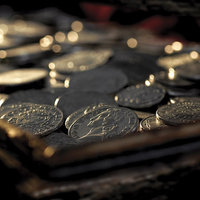Categories Coins Germany
Coins

Coins provide an opportunity to make the past concrete. Try to investigate the story of the coin. What is the backround of the free town Danzig, German East Africa or the independent Saarland. Take the chance to hold history in your hands.
Middle Ages
In the Middle Ages were issued a lot of different values and alloys. The was no organized harmonization in the coinage.
Kingdom of Prussia
Kingdom of Prussia 1701-1918
Capital: Berlin
Coins before the introduction of the Reichsmark until 1871
Kingdom of Saxony
1806-1918 Kingdom of Saxonia
1854–1873 Johann
1873–1902 Albert
1902–1904 Georg
1904–1918 Friedrich August III.
German Empire
German Empire - 1871 to 1918
- Wilhelm I. (1871-1888)
- Friedrich III. (1888)
- Wilhelm II. (1888-1918)
Separate Areas
Supreme Commander East
Belgium with German Occupation
Planned Kingdom of Poland
Protectorate Bohemia and Moravia
Free Town Danzig
Weimar Republic
The "Weimar Republic" contains the period between the proclamation of the first parliamentary democracy 1918.11.9 and 1933.1.30.
Token Coins Germany 1918-1923
Coins out of the period between Worldwar 1st and the hyperinflation in Germany (1918-1923).
Third Empire
Period of Nationalsocialism between 1933 and 1945.
Leader and Reich Chancellor: Adolf Hitler
Allied Occupation
During the post-war era in all four occupied zones were issued common coins until the foundation of the federal republic of Germany.
Saarland
1954 to 1956
Area: 2.570 km² - 948.000 Inhabitants (1950)
Monetary Reform July 6th 1959: 100 Franken = 0,8507 Deutsche Mark
Bank of German Countries
In the united economic region of the western allied military authority the Bank of german countries started 1948 to issue coins.
German Democratic Republic
1948 to 1990 Deutsche Demokratische Republik
Currency: 1 Deutsche Mark (East) = 100 Pfennig
Federal Republic of Germany
1950 until today. Issues of the German National Bank for the Federal Republic of Germany in German Mark or Pfennig.















